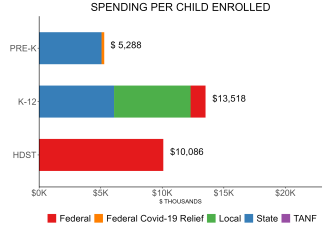
State of Preschool
Georgia
Access Rankings
Resource Rankings
Total Benchmarks Met
Overview

During the 2021-2022 school year, Georgia preschool enrolled 73,177 children, an increase of 6,623 from the prior year, as the program began to recover from the impact of the COVID-19 pandemic. State spending totaled $370,958,408, with an additional $15,988,500 in federal recovery funds to support the program, down $4,576,209 (1%), adjusted for inflation since last year. State spending per child (including federal recovery funds) equaled $5,288 in 2021-2022, down $595 from 2020-2021, adjusted for inflation. Georgia met 8 of 10 quality standards benchmarks.
What's New

During the 2021-2022 school year, Georgia Pre-K Program classrooms returned to in-person instruction with only interim closures due to COVID-19 cases. Lead and assistant teachers received a $125 grant per individual to purchase classroom supplies and materials through CRRSA funding. In addition, lead and assistant teachers received a $2,000 bonus. The state budget also included a $2,000 pay increase for all lead teachers PK–grade 12. In Georgia’s Pre-K budget, the pay increase was for all lead and assistant teachers in public and private settings. To help mitigate the impact of the pandemic on school readiness, GEER funding was utilized to expand the Pre-K Summer Transition Program to serve an additional 2,000 students.
Background
Georgia’s Pre-K Program launched in 1992 as a small pilot program and expanded in 1995 to become the nation’s first state-funded universal preschool program for 4-year-olds. State lottery revenues generate funding for the program, which is provided in a variety of settings, including public schools, private child-care centers, faith-based organizations, Head Start agencies, state colleges and universities, and military facilities.
In 2011, the Georgia General Assembly authorized an evaluation of Georgia’s Pre-K Program. In response to the General Assembly, DECAL commissioned national experts at the Frank Porter Graham Child Development Institute at the University of North Carolina at Chapel Hill to conduct a series of studies to measure the impact of the state’s nationally renowned Pre-K program. Reports and summaries from the studies are available here: http://decal.ga.gov/BftS/EvaluationGAPreKProgram.aspx.
Reports include recent results from the Pre-K Longitudinal Study designed to examine the short- and long-term learning outcomes for children who attended Georgia’s Pre-K as well as the quality of their preschool and early elementary school experiences. The report from the fifth year of the study was issued in January 2021. The final report with findings through the fourth grade will be issued in spring 2023.
Georgia's Pre-K Program
Access
Resources
| Total state pre-K spending | $386,946,908 |
| Local match required? | No |
| State Head Start spending | $0 |
| State spending per child enrolled | $5,288 |
| All reported spending per child enrolled* | $5,288 |

Pre-K programs may receive additional funds from federal or local sources that are not included in this figure. K–12 expenditures include capital spending as well as current operating expenditures. Head Start per-child spending includes funding only for 3- and 4-year-olds.
Georgia Quality Standards Checklist
| Policy | Requirement | Benchmark | Meets Benchmark? |
|---|---|---|---|
For more information about the benchmarks, see the Executive Summary and the Roadmap to State pages. | 8benchmarks met | ||
| Early Learning & Development Standards Benchmark | Comprehensive, aligned, supported, culturally sensitive | Comprehensive, aligned, supported, culturally sensitive | |
| Curriculum Supports Benchmark | Approval process & supports | Approval process & supports | |
| Teacher Degree Benchmark | BA | BA | |
| Teacher Specialized Training Benchmark | ECE, CD, ECE SpEd | Specializing in pre-K | |
| Assistant Teacher Degree Benchmark | CDA | CDA or equivalent | |
| Staff Professional Development Benchmark | 15 hours/year; PD plans; Coaching | For teachers & assistants: At least 15 hours/year; individual PD plans; coaching | |
| Maximum Class Size Benchmark | 22 (4-year-olds) | 20 or lower | |
| Staff to Child Ratio Benchmark | 1:11 (4-year-olds) | 1:10 or better | |
| Screening & Referral Benchmark | Vision, hearing, health & more | Vision, hearing & health screenings; & referral | |
| Continuous Quality Improvement System Benchmark | Structured classroom observations; Data used for program improvement | Structured classroom observations; data used for program improvement | |

